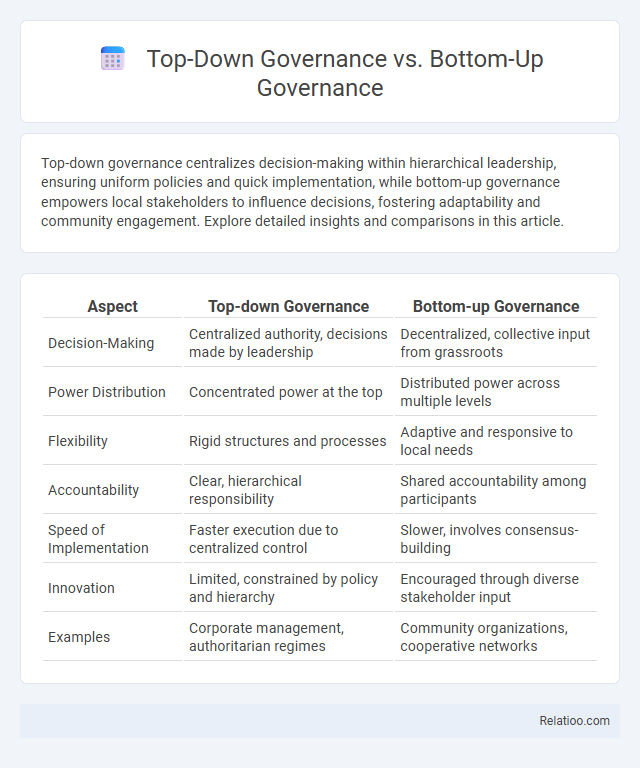Top-down governance centralizes decision-making within hierarchical leadership, ensuring uniform policies and quick implementation, while bottom-up governance empowers local stakeholders to influence decisions, fostering adaptability and community engagement. Explore detailed insights and comparisons in this article.
Table of Comparison
| Aspect | Top-down Governance | Bottom-up Governance |
|---|---|---|
| Decision-Making | Centralized authority, decisions made by leadership | Decentralized, collective input from grassroots |
| Power Distribution | Concentrated power at the top | Distributed power across multiple levels |
| Flexibility | Rigid structures and processes | Adaptive and responsive to local needs |
| Accountability | Clear, hierarchical responsibility | Shared accountability among participants |
| Speed of Implementation | Faster execution due to centralized control | Slower, involves consensus-building |
| Innovation | Limited, constrained by policy and hierarchy | Encouraged through diverse stakeholder input |
| Examples | Corporate management, authoritarian regimes | Community organizations, cooperative networks |
Introduction to Governance Frameworks
Governance frameworks define how decisions are made and implemented within organizations or societies, focusing on the distribution of authority and accountability. Top-down governance emphasizes centralized control and directive leadership, while bottom-up governance prioritizes participatory decision-making and grassroots involvement. Understanding these contrasting approaches helps you design effective governance systems tailored to organizational goals and stakeholder engagement.
Defining Top-down Governance
Top-down governance is a hierarchical approach where decision-making authority is concentrated at the upper levels of an organization or government, ensuring consistent policy enforcement and streamlined implementation. This model contrasts with bottom-up governance, which emphasizes participatory decision-making and grassroots input to foster inclusivity and local adaptability. Understanding top-down governance involves recognizing its role in centralized control, clear chain of command, and efficient resource allocation within complex institutions.
Understanding Bottom-up Governance
Bottom-up governance emphasizes community participation, empowering local stakeholders to influence decision-making processes directly, which contrasts with top-down governance where directives flow from centralized authorities. Understanding bottom-up governance reveals how it fosters transparency, accountability, and adaptability by leveraging grassroots knowledge and collective input. Your engagement in this model enhances policy relevance and responsiveness, ensuring governance structures better address local needs and priorities.
Key Principles and Characteristics
Top-down governance emphasizes hierarchical decision-making, centralized authority, and clear directives enforced by top management to ensure uniformity and compliance across organizations. Bottom-up governance encourages participation, collaboration, and feedback from lower levels, fostering adaptability, innovation, and diverse stakeholder engagement. Effective governance integrates both approaches by balancing control with inclusiveness, aligning strategic objectives with operational insights to enhance transparency and accountability.
Decision-making Processes Compared
Top-down governance centralizes decision-making authority, ensuring uniform policy implementation but potentially limiting local input and flexibility. Bottom-up governance emphasizes participatory decision-making, empowering local stakeholders to influence policies, which can enhance community engagement and adaptability. Your choice between these models impacts how efficiently decisions are made and how responsive governance is to specific needs and contexts.
Stakeholder Roles and Engagement
Top-down governance centralizes decision-making authority, where leadership defines goals and stakeholders primarily execute directives, often resulting in limited engagement and reduced innovation from lower levels. Bottom-up governance emphasizes active stakeholder participation, enabling employees, community members, or users to contribute insights and co-create solutions, fostering ownership and more adaptive policies. Effective governance integrates both approaches, aligning leadership vision with stakeholder input to enhance collaboration, accountability, and responsive organizational performance.
Advantages of Top-down Governance
Top-down governance centralizes decision-making authority, ensuring consistent policy implementation and streamlined management across organizations or governments. This structure facilitates clear accountability and faster response to strategic objectives, particularly in complex or large-scale systems. Your organization benefits from reduced ambiguity and unified direction, which drives efficiency and coherence in achieving institutional goals.
Benefits of Bottom-up Governance
Bottom-up governance empowers communities by encouraging active participation, fostering transparency, and enabling decision-making that directly reflects local needs and priorities. This approach enhances accountability and improves policy outcomes by incorporating diverse perspectives, leading to solutions that are more sustainable and inclusive. Your organization can benefit from bottom-up governance through increased trust, stronger collaboration, and more responsive management practices.
Case Studies and Real-world Examples
Case studies reveal that top-down governance excels in crisis management, exemplified by Singapore's swift COVID-19 response driven by centralized decision-making. Bottom-up governance fosters community engagement, as demonstrated by Porto Alegre's participatory budgeting model, empowering citizens to influence local spending. Your choice of governance approach significantly impacts effectiveness, depending on societal needs and administrative contexts.
Choosing the Right Governance Model
Choosing the right governance model depends on the organization's size, goals, and culture, with top-down governance providing clear authority and centralized decision-making for fast, consistent outcomes. Bottom-up governance encourages stakeholder participation and innovation by integrating diverse perspectives, which can improve adaptability and employee engagement. Your decision should balance control needs with flexibility to ensure effective policy implementation and organizational alignment.

Infographic: Top-down Governance vs Bottom-up Governance
 relatioo.com
relatioo.com